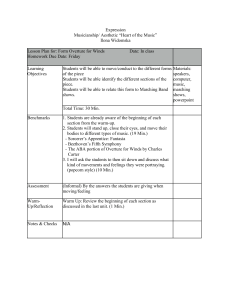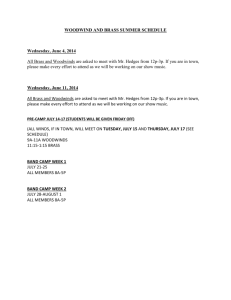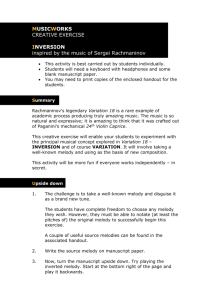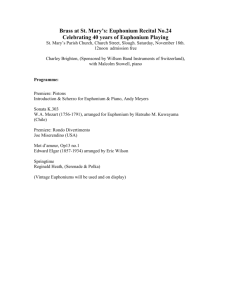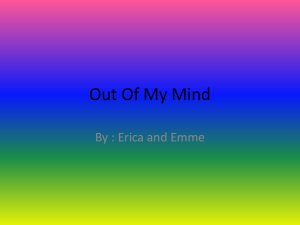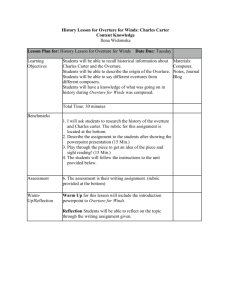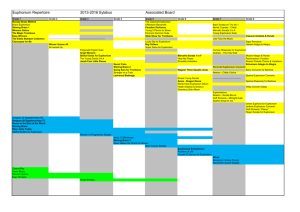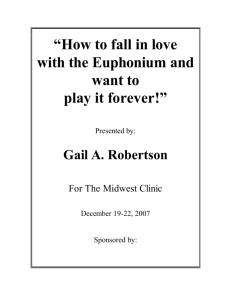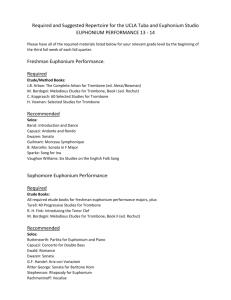File
advertisement
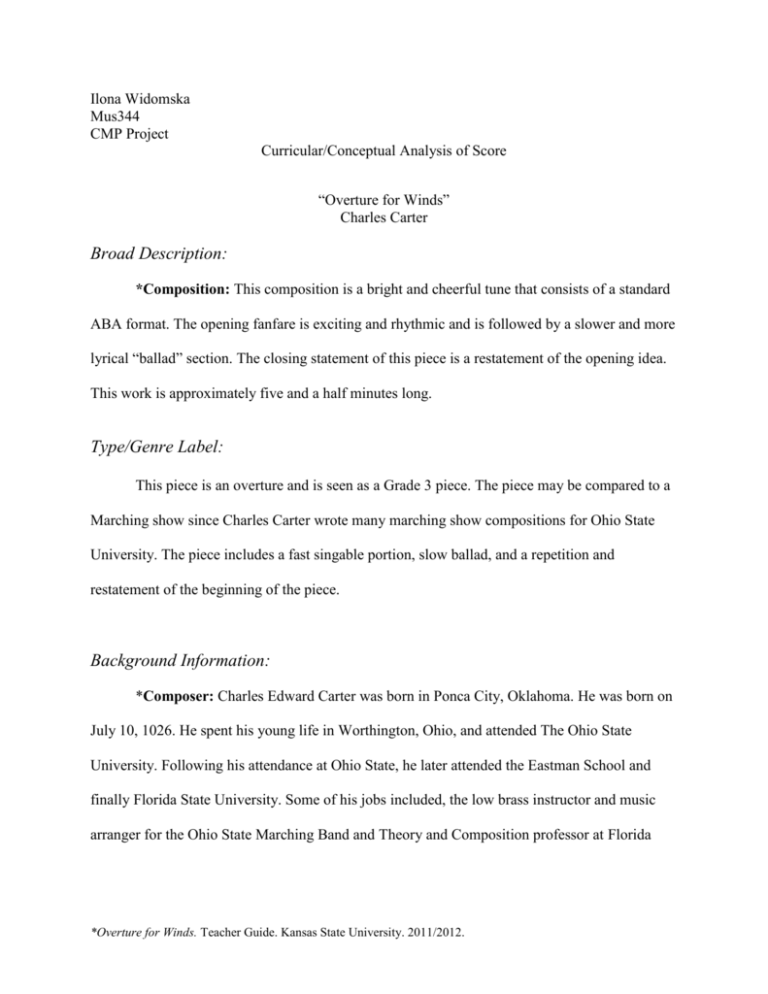
Ilona Widomska Mus344 CMP Project Curricular/Conceptual Analysis of Score “Overture for Winds” Charles Carter Broad Description: *Composition: This composition is a bright and cheerful tune that consists of a standard ABA format. The opening fanfare is exciting and rhythmic and is followed by a slower and more lyrical “ballad” section. The closing statement of this piece is a restatement of the opening idea. This work is approximately five and a half minutes long. Type/Genre Label: This piece is an overture and is seen as a Grade 3 piece. The piece may be compared to a Marching show since Charles Carter wrote many marching show compositions for Ohio State University. The piece includes a fast singable portion, slow ballad, and a repetition and restatement of the beginning of the piece. Background Information: *Composer: Charles Edward Carter was born in Ponca City, Oklahoma. He was born on July 10, 1026. He spent his young life in Worthington, Ohio, and attended The Ohio State University. Following his attendance at Ohio State, he later attended the Eastman School and finally Florida State University. Some of his jobs included, the low brass instructor and music arranger for the Ohio State Marching Band and Theory and Composition professor at Florida *Overture for Winds. Teacher Guide. Kansas State University. 2011/2012. State University. He is most known for his published wind band literature. He composed Overture for Winds, Chorale and Variations, and Symphonic Overture to name a few. Elements of the Music *Technical Considerations (Melody): The keys that this piece contains are centered around Eb Major, C minor and Bb Major. The tempo at the beginning of the piece is marked allegro con moto with the quarter note equaling 152 beats per minute. The piece has a recurring theme of upbeat entrances in all sections of the piece. The piece begins with the woodwinds taking the melody in the piece. *Rhythmic Considerations: Being rhythmically precise is very important in this particular piece of music; especially while Theme A is being performed. The middle, more lyrical section may be performed with more rubato and with more emotion. Balance is not really an issue with the melody always being represented with a strong underlying accompaniment. *Musical/Harmonic Elements: The harmony is predominantly triadic and the melodies are very melodic if you will. With most all of the entrances coming on the upbeats, it may cause some players a bit of difficulty. Cadences are ending mostly on the dominant I chord. The B section is very polyphonic after the transition from the euphonium solo. Form: The form of this piece is ABA’ and goes from a staccato, legato, then back to a staccato style. The form also includes a transition in the Euphonium solo and a coda. The theme a is played by the woodwinds at the beginning with the brass playing the b theme underneath with a countermelody as mentioned in the melody paragraph. The beginning theme is singable *Overture for Winds. Teacher Guide. Kansas State University. 2011/2012. and very rhythmic. In Form B, all instruments are playing the c theme for the piece which turns into a slow, lyrical, and expressive portion. In A’ the piece repeats the beginning with a few a ritardando at the end. Timbre: The beginning of the piece is very bright in tone color. The middle of the piece is warmer and legato. The end of the piece goes back to a bright singable sound. The piece is very woodwind heavy with the brass only accompanying and not too much percussion. The transition from a bright to warm sound happens with a short four measure euphonium solo. Texture: Most of the piece is full with texture in full instrumentation. The percussion is not featured too much in the piece in the cymbal crashes at the end of the piece. The beginning includes all instruments, but mainly features the woodwinds with the high pitches and forte dynamics. The brass does not play too much of the melody in the piece. The euphonium plays a short solo in the transition from a full to less textured area at B. The texture at B is less full than the beginning with the brass playing less and quieter. The woodwinds still play in a high octave but must try to play it at a piano marking. The end of the piece is the same as the beginning with a full texture and percussion. Expression: The beginning of the piece is very bright and singable. A student may easily be singing this melody down the hallways after class. This piece wants to make one leave a room happy and excited with the bright tempo. At section B, the piece is more legato and is heart warming with the entrance of the beautiful euphonium solo. The woodwinds take the melody with the trumpets following. The melody is very heart warming with an “AHA” moment with the *Overture for Winds. Teacher Guide. Kansas State University. 2011/2012. suspended cymbal. The A’ section, repeats to a bright tempo and a singable melody played by the woodwinds. The Heart of the Music There are multiple portions of the piece that make this piece worthy of playing. The Heart of the music is the themes, melodies, and countermelodies that occur in the piece. The slow beautiful euphonium solo sets up the B portion of the piece to make the woodwinds and brass ooze for the audience. The form of the piece makes the piece worth while to teach students and is great to relate to Marching Band. The heart of the music is also the difficulty in syncopated rhythms for the students to achieve by keeping a steady tempo, then switching to rubato in the B section. Concepts The concepts that can be taught through this piece is intonation, rhythm, articulations, key signatures, melody, and expressiveness. The first is intonation, there are many notes that the students will need to hold out which may result going flat if support is not reinforced. This is a perfect opportunity to stress the importance of breathing exercises (in lesson plan) and support through the notes. The next is rhythm, section A is very rhythmic and may result in a crash and burn if certain instruments are not in tempo. The B section is a ballad and a bit more rubato in tempo. The A’ section, is similar to the beginning with difficult syncopated rhythms for beginners. The next item is, the variety of articulations in the piece. The piece includes staccato, marcato, and legato tonging. This is a great opportunity to discuss syllables used for each type of articulations. This will be taught on “dah”, “doh’, and “daht.” Key signatures will also be taught *Overture for Winds. Teacher Guide. Kansas State University. 2011/2012. and the students will be able to learn about relative keys. This will help the students in sight reading future pieces. Melody and expressiveness will be taught in the second movement at the ballad. This will help students listen to preceding instruments and how to match sound and phrasing. Overall, this piece is worthwhile to learn because of the many concepts that can be brought up for advanced beginner ensembles. The piece will be relatable to the students through marching band. The piece will also leave them signing the tune in the hallways. *Overture for Winds. Teacher Guide. Kansas State University. 2011/2012.
